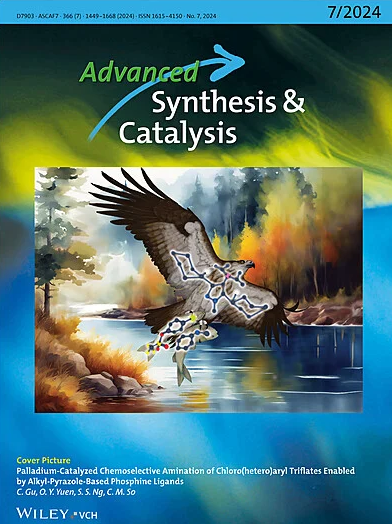Photocatalytic C−I Bond Borylation and Phosphorylation of Diaryliodonium Salts with Excellent Atom‐Economy
IF 4
2区 化学
Q2 CHEMISTRY, APPLIED
引用次数: 0
Abstract
Highly atom‐economic conversion of diaryliodonium salts represents an underdeveloped but highly desirable domain. Most reactions involving these species only utilize single aryl group of the diaryliodonium salts and produce an equivalent of aryl iodide as waste. Herein, by further transforming the side‐product aryl iodide, we report an overall new two‐step one‐pot strategy that allows photocatalytic C−I bond borylation of diaryliodonium salts and ensures effective conversion of both aryl groups of the diaryliodonium into the relevant arylboronic esters. Mechanistic investigations suggest that electron‐donor‐acceptor complex is formed between the photocatalyst phenothiazine and diaryliodonium salt substrate. Upon visible light irradiation, this complex produces aryl radical and aryl iodide. With addition of a base in the second step, the reducing ability of the photocatalyst is enhanced via proton‐coupled electron transfer process, thereby aryl iodide produced in the first step is reduced to yield aryl radical again. Both aryl radicals generated in the two steps react with B2(OR)4 to produce the corresponding monoarylation product in a quantitative yield. The strategy is also applicable for C−I bond phosphorylation of diaryliodonium salts, ensuring that both aryl moieties can be phosphorylated with high efficiency.

具有优异原子经济性的二芳基碘鎓盐的光催化C-I键硼化和磷酸化
高原子经济性的二芳基碘鎓盐转化是一个不发达但非常理想的领域。大多数涉及这些物种的反应只利用二芳基碘的单个芳基,并产生相当于碘化芳基的废物。在此,通过进一步转化副产物芳基碘化物,我们报告了一种全新的两步一锅策略,该策略允许光催化二芳基碘鎓盐的C - I键硼化和磷酸化,并确保二芳基碘鎓的两个芳基有效转化为相关的芳基硼酯或芳基膦酯。机理研究表明,在光催化剂吩噻嗪(PTH)和二芳基碘鎓盐底物之间形成电子给受体(EDA)络合物。在可见光照射下,该络合物产生芳基自由基和芳基碘化物。第二步加入碱后,通过质子耦合电子转移(PCET)过程增强光催化剂的还原能力,从而使第一步产生的芳基碘化物再次还原生成芳基自由基。这两步生成的芳基自由基均与B2(OR)4或P(OR)3反应,定量生成相应的单芳基化产物。
本文章由计算机程序翻译,如有差异,请以英文原文为准。
求助全文
约1分钟内获得全文
求助全文
来源期刊

Advanced Synthesis & Catalysis
化学-应用化学
CiteScore
9.40
自引率
7.40%
发文量
447
审稿时长
1.8 months
期刊介绍:
Advanced Synthesis & Catalysis (ASC) is the leading primary journal in organic, organometallic, and applied chemistry.
The high impact of ASC can be attributed to the unique focus of the journal, which publishes exciting new results from academic and industrial labs on efficient, practical, and environmentally friendly organic synthesis. While homogeneous, heterogeneous, organic, and enzyme catalysis are key technologies to achieve green synthesis, significant contributions to the same goal by synthesis design, reaction techniques, flow chemistry, and continuous processing, multiphase catalysis, green solvents, catalyst immobilization, and recycling, separation science, and process development are also featured in ASC. The Aims and Scope can be found in the Notice to Authors or on the first page of the table of contents in every issue.
 求助内容:
求助内容: 应助结果提醒方式:
应助结果提醒方式:


